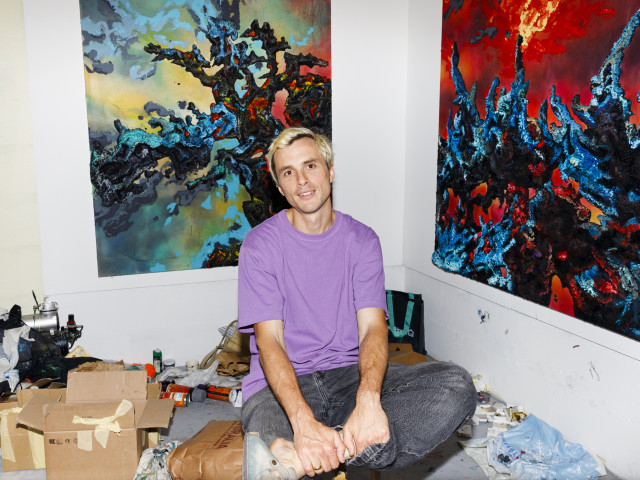Lucien Murat (b. 1986) had previously accustomed viewers with truncated, tapestry - like in their meticulousness, constructions evoking imageries of violence or war. Throughout this new series of works, the French artist puts forward the act of painting itself, a reflection carried through a questioning of how artificial intelligence might perceive humanity’s ill treatment of the planet and environment.
Visually, the materialistic works on view might not immediately give way to their underlying meaning. Their creation process is anchored within a recurring starting point that has guided Murat for several years: questioning the translation of a digital subject into analogue format or how to depict computer-generated images, in this instance, into a painterly language. Resulting paintings are dense, thickly layered in somewhat garish colours, oscillating between the realms of reality and science fiction. The artist looks to shine light onto a hidden world, that one’s mind cannot fully comprehend due to its innate psychological protection.
Murat’s process of creation is multi-layered and multimedia: besides painting, he
consistently employs stitching and sewing of various textiles, and has more recently started accumulating found materials, repurposed as backgrounds within present paintings. The latter create unexpected, magma-like surfaces that both fix and unsettle the viewer’s eye through their vivacity, or deliberate dullness.
Conceptually, Murat questions the very act of painting, especially as a landscape or reflection of our time: not only saturated with images, but in which nature fares poorly. Simultaneously, he employs artificial intelligence, which endlessly captivates and fascinates the artist, as an attempt of regaining authenticity.
If the narration and story open themselves, in this new series of paintings and drawings, to more texturization of materials and abstraction, they cannot conceal a form of virulence and impetuosity. Perhaps even a kind of anger or dull, silent fury, like this nature that we often destroy without a sound. Murat admits to favouring literature over art, particularly that of William Faulkner. Like the American writer, might Murat be positioning himself against a certain injustice and, without providing miracle solutions, bear witness to harsh realities that haunt us?
Historically and particularly throughout French history of art, one notices that such rough surfaces and materials resonate in times of war and post-war... Names as Jean Fautrier or Jean Dubuffet immediately resonate, as their oeuvre evoke without ever explicitly naming the horrors of the past, while calling into question the traditional values of painting as a medium. It is in this spirit that Murat finds himself, in the spirit of his great predecessors, who during times of unrest, called for the necessity of a new type of painting - “stronger, without aftertaste, more authentic”, as Daniel Abadie defined it in the exhibition catalogue of Center Pompidou’s exhibition titled Paris-Paris.
Fleeing overly coded, identical, stereotypical, even kitsch creations, Murat refers to the Czech-French novelist Milan Kundera (1929-2023), and his denouncement of the notion of embellishment of lies. As such, is Murat striving to show what the viewer refuses to see? Or, even further, to confront one with an imminent reality that is made attractive through its pictorial depiction? With these open questions in mind, the works on view appear at the intersection of a digital contribution which would guide us, despite its artificial side, towards a type of prophecy. In the end, the question of “What do we choose to believe?” is the overarching subject of these artworks, and perhaps of Murat’s entire oeuvre.
— Marie Maertens —
Art Critic

